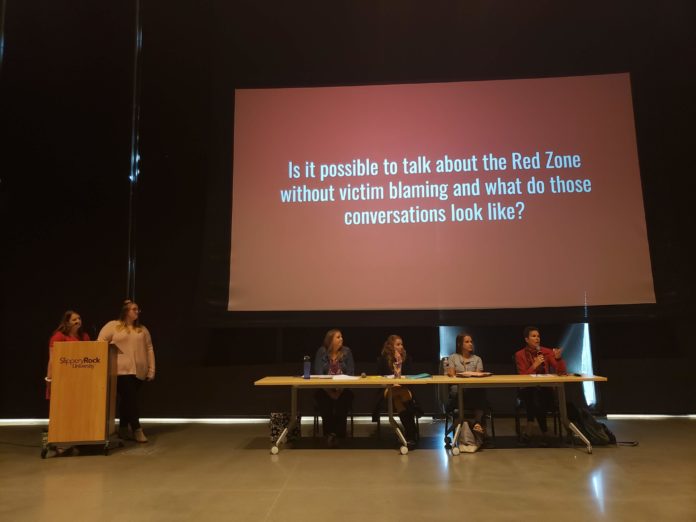
“What prevents rape?” Graduate Assistant Erin O’Connor asked. “Not raping someone,” she said.
O’Connor, the Graduate Assistant to the Women’s and Pride Center was one of four panelists Tuesday afternoon at the discussion, “Consent is Mandatory: Rape Culture and the Red Zone.”
The discussion was hosted by the Feminist Majority Leadership Alliance (FMLA) who also had their President Maggie Calvert, senior political science, philosophy and gender studies major and Vice President Piper Jones, junior social work and gender and diversity studies major monitoring the event.
Joining O’Connor on the panel were sociology professor Dr. Richelle Dysktra, Dr. Cindy LaCom, Director of the Gender Studies program and Kaeleen, a Victim’s Advocate for Butler County Victim Outreach Intervention Center (VOICe).
The discussion began by giving a statistic involving the Red Zone: more than 50% of assaults occur during the first six weeks of the fall semester, otherwise known as the Red Zone.
The panelists were prompted to their first question, “from your perspective related to your field, can you talk about 1-2 reasons why you believe the Red Zone exists?”
Dykstra identified various factors of rape, including cultural, structural and micro identity.
“The cultural and structural factors lead us to believe that we are living in a rape culture where qualities and characteristics of rape are normalized,” Dykstra said.
Along with cultural factors, Dykstra said that the structure of the justice system is rape without impunity, teaching victims that rape is a normal part of life.
LaCom said that sex and sexuality were repressed, and that the community talks about rape in the MeToo movement, but that an impulse to not talk about rape still exists.
“Imagine if the university sent acceptance letters to women saying ‘congratulations, national data tells us that 25% of you are going to be victims of sexual assault or rape, welcome,” LaCom said.
Sexual violence occurs at higher rates throughout the year.
One main theme, from all panelists, was that the conversation about rape needs to be flipped from the victim to the perpetrator, leading to the question “is it possible to talk about the Red Zone without victim blaming?”
Graduate Assistant O’Connor said that people are constantly thinking about what the victim was doing and that consent needs to be the forefront of the conversation.
“There are people who are choosing to sexually assault someone,” O’Connor said. “We need to hold people accountable for their autonomy and decisions.”
Kaeleen agreed that the conversation is focused around victim blaming.
“It’s not the victim’s fault,” Kaeleen said. “Being raped should not be a consequence for getting drunk at a party.”
Dkystra, decided to play more of a devil’s advocate role and brought up the idea that there is a lack of socialization of alcohol consumption. She explained how alcohol creates an atmosphere for taking advantage of people and suggests that lowering the drinking age will allow experience with alcohol before arriving to college.
“Where alcohol is available, that becomes a hot bed for the Red Zone,” Dkystra said.
However, LaCom believes that students, faculty and the community have the power to change the culture of victim blaming, starting with the kids.
LaCom said that children engaged in gender segregated play allows them to believe that their genders are different.
“When young girls can buy an ‘exercise pole’, another name for a stripper pole, as an accessory for their Bratz doll, and they sell thongs and padded bras for children at Walmart, it teaches girls that the primary object is to be desired,” LaCom said.
Although, for education to start at young age, rape and the Red Zone education must also be prevalent in higher education.
O’Connor said that there is an absence of this education leading up to and into higher education.
“The Red Zone isn’t included in education because it’s not seen as a preventative measure,” O’Connor said.
Dykstra agreed. She believes that this is a national problem, therefore, it necessitates a national program. However, Dykstra also believes that by virtue of being required, the program itself can become a joke.
With a splurge for rape and Red Zone education in both primary, secondary and higher education, Kaeleen believes that a balance needs to be found between educating and terrifying, reminding students of the services that VOICe provides.
VOICe has a hotline that is available 24 hours, confidential counseling, legal advocates and attorneys, medical advocacy and the opportunity to accompany victims if they are being transported to a hospital.
There are on campus resources as well. The Women’s center provides a space for private, sensitive and serious conversations and is an opportunity nearby to help students lay out their options.
VOICe and the Women’s Center will aid both males and females in the decision to choose their next step but will not tell them what their next choice should be.
Although all four panelists believe that the conversation surrounding rape and the Red Zone needs to flip the script from the victim to the perpetrator and education needs to be more prevalent, Dykstra brought up the question that is often asked surrounding the perpetrators and rape, “what am I supposed to do now?”
“My answer is behave like a human,” Dykstra said.







